In response to the
World Summit on the
Information Society (WSIS) goals, the
World Information Society
Report 2006 tracks the changing dynamics driving the Information Society
worldwide, with a new tool—the Digital Opportunity Index (DOI)—that evaluates
the opportunity, infrastructure and utilization of Information and Communication
Technologies (ICTs) for 180 economies worldwide.
|
The DOI has been developed by a
multi-stakeholder partnership, the
Digital
Opportunity Platform,
comprising ITU, UNCTAD and KADO (the
Korea Agency for Digital Opportunity and
Promotion). |
In line with earlier
studies, DOI results are closely related to income.
Countries differ widely, with a considerable digital
divide between the highest-achieving economy
(Republic of Korea) and the economies rated last.
Results are geographically mixed, with both European
and Asian countries appearing in the top ten, while
Asian and African countries feature among the lowest
ten.
In low-income countries, digital opportunity
derives from access to cellular service and affordable telecoms, whilst
high-income countries are realizing their digital opportunities in good
infrastructure and the use of advanced technologies.
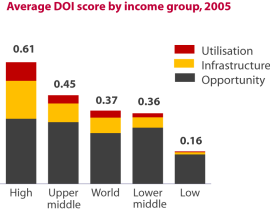
The DOI illustrates the strong lead taken by
Europe and North America in realizing digital opportunity. Latin America and
Central Asia are catching up fast with large infrastructural investments and
strong gains in mobile and Internet subscribers, including 3G mobile
technologies (CDMA 2000 1x and W-CDMA). Two Asian countries top the rankings –
the Republic of Korea and Japan - followed by Denmark and Iceland. Chile leads
in Latin America, whilst Morocco leads in Africa.
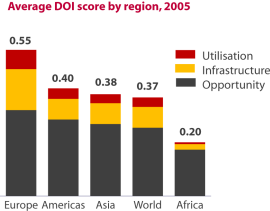
Source: World Information Society Report
2006. |
|
|
Looking at the sub-categories composing the DOI,
the one with the highest average value is Opportunity. This category
measures basic access (reflected by mobile coverage) and affordability of
networks. Many countries have widespread coverage of mobile networks (though not
necessarily corresponding high levels of penetration). In the group of sample
countries, affordability is not a major bottleneck for most. Even if internet
pricing is less affordable, the prices of broadband services have decreased with
around 40% over the last three years, according to ITU analysis.
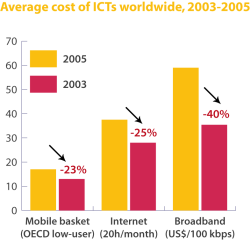
The analysis based on the results of the Digital
Opportunity Index 2005 suggest that for most countries, policy should now
emphasize Infrastructure and Utilization. In terms of the Infrastructure
category, the average value is 0.23. Most developed economies score over 0.5 but
well below one. One reason is that even in developed nations there are still
“ICT have nots”. Developing nations score far lower in this category, given the
relatively high cost of advanced ICT equipment such as computers and Internet
access and the fact that public access, which is not captured in the index,
often plays a significant role.
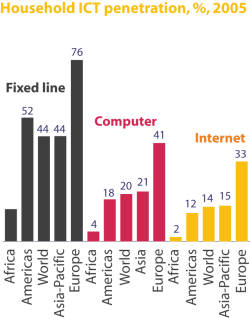
The lowest scores are recorded in the
Utilization category. Less than a tenth of the economies in the sample have
half of their population online. While some developed nations have high levels
of fixed broadband, few countries have corresponding high levels of mobile
broadband. This is likely to change with the recent uptake of 3G deployments.
The average category scores reflect a natural progression of ICT evolution, from
coverage and affordability, to infrastructure and finally quality. While the
world has passed the first level, one might say it is less than “half-way” there
in terms of the second and still has far to go to achieve the third.
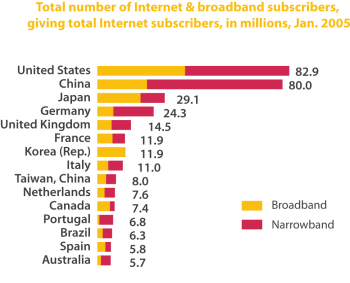
For more analysis of the status of Digital
Opportunity in 2005, you can consult the
World Information Society
Report 2006. |
|
The Asian economies of the Republic of Korea and
Japan continue to lead in digital opportunity, due to their pioneering take-up
of broadband and 3G mobile services. Asian Tigers and Nordic countries are among
the top ten economies, with a number of Western European countries among the
high teens. Central and Eastern European nations featured among the low
twenties.
|
Rank |
Economy |
Digital
Opportunity Index categories |
|
Oppor-
tunity |
Infra-structure |
Use |
DOI |
|
1 |
Korea (Rep.) |
0.99 |
0.74 |
0.64 |
0.79 |
|
2 |
Japan |
0.99 |
0.69 |
0.46 |
0.71 |
|
3 |
Denmark |
0.99 |
0.75 |
0.37 |
0.71 |
|
4 |
Iceland |
0.99 |
0.72 |
0.37 |
0.69 |
|
5 |
Hong Kong |
1.00 |
0.70 |
0.38 |
0.69 |
|
6 |
Sweden |
0.99 |
0.74 |
0.35 |
0.69 |
|
7 |
United Kingdom |
0.99 |
0.68 |
0.33 |
0.67 |
|
8 |
Norway |
0.99 |
0.66 |
0.34 |
0.67 |
|
9 |
Netherlands |
0.99 |
0.67 |
0.32 |
0.66 |
|
10 |
Taiwan, China |
0.99 |
0.69 |
0.29 |
0.66 |
|
11 |
Macao, China |
1.00 |
0.66 |
0.30 |
0.65 |
|
12 |
Australia |
0.98 |
0.63 |
0.35 |
0.65 |
|
13 |
Israel |
0.98 |
0.57 |
0.40 |
0.65 |
|
14 |
Canada |
0.98 |
0.55 |
0.43 |
0.65 |
|
15 |
Switzerland |
0.99 |
0.63 |
0.33 |
0.65 |
|
16 |
Singapore |
1.00 |
0.68 |
0.27 |
0.65 |
|
17 |
Finland |
0.99 |
0.60 |
0.34 |
0.64 |
|
18 |
Luxembourg |
0.99 |
0.65 |
0.27 |
0.64 |
|
19 |
Germany |
0.99 |
0.64 |
0.27 |
0.63 |
|
20 |
Estonia |
0.98 |
0.47 |
0.44 |
0.63 |
|
21 |
United States |
0.98 |
0.55 |
0.34 |
0.62 |
|
22 |
Slovenia |
0.98 |
0.63 |
0.26 |
0.62 |
|
23 |
Belgium |
0.99 |
0.50 |
0.38 |
0.62 |
|
24 |
Austria |
0.99 |
0.54 |
0.34 |
0.62 |
|
25 |
Spain |
0.99 |
0.54 |
0.30 |
0.61 |
You can consult the full DOI ranking of 180 economies worldwide
Note: On a scale of 0 to 1 where 1 =
highest value. Economies with the same DOI value are ranked by thousands of a
decimal point.
Source: ITU/KADO Digital Bridges Project. |
|
|
Based on the time series of the Digital Opportunity
Index, covering the period 2001-2005 for 40 leading economies, developments in
digital opportunity can be track. Dramatic progress has been achieved by
developing countries, however, which made the greatest progress in digital
opportunity - notably India, where digital opportunity nearly doubled between
2001 and 2005, and China, which experienced remarkably strong gains in
infrastructure. Different countries are following their own paths in
telecommunication development, with some countries leveraging their investments
in infrastructure more successfully than others.
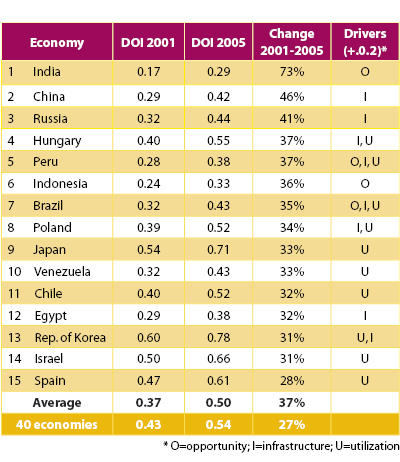
Source:
World Information Society
Report 2006.
|
|
The Digital Opportunity Index monitors the mobile
communications that promise to bridge the digital divide in many parts of the
world, as well as more recent technologies such as broadband and mobile internet
access.
Broadband
Nearly all internet subscribers in the Republic
of Korea are broadband subscribers, whilst Japan is the only market where
Internet subscribers are most likely to access Internet over their mobile.
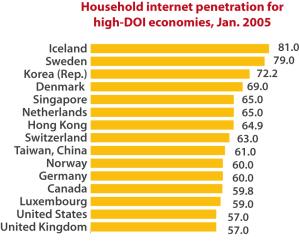
Mobile
The DOI registers a steady expansion un the
number of mobile internet subscribers. Most notably, the DOI shows that mobile
internet and 3G services are no longer the preserve of high-income countries.
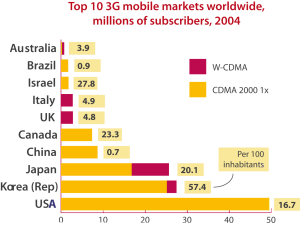
Questions & Answers on the Digital Opportunity Index
|
|



